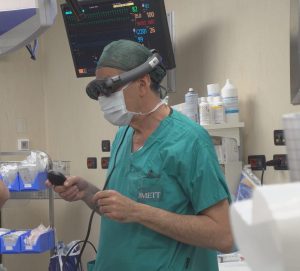For the first time at any UPMC facility, and any health center in all of Italy, UPMC is leveraging augmented reality to assist with minimally invasive cardiac procedures.
The first procedure was recently performed by a team led by Francesco Musumeci, senior consultant in Cardiac Surgery at UPMC-ISMETT in Palermo, Italy, leveraging the technology developed by their research lab to perform a left atrial appendage closure procedure.
The technology provides a three-dimensional (3D) organ reconstruction so surgeons can interact with a real-time, computer-generated hologram which stimulates the procedure being performed on the patient. The hologram of the patient’s chest and heart were reconstructed from the CT scan, and a simulation was created to allow for more accurate surgical planning.

Francesco Musumeci, Senior Consultant in Cardiac Surgery at UPMC ISMETT, uses Augmented Reality in a cardiac surgery for the first time at any UPMC facility and any health center in Italy.
“We decided to intervene surgically using a minimally invasive method,” said Musumeci. “The ISMETT research lab’s focus on the development of augmented and virtual reality in the medical field stimulated us to use these technologies.”
ISMETT’s research on augmented and virtual reality led to the development of precise and efficient technologies to be used in a variety of surgical procedures and patient care settings.
Augmented reality is an interactive experience that enhances real-world procedures through computer-generated perceptual information from images of diagnostic tests, like a CT scan, MRI or ultrasound. It creates a 3D simulation of reality with which surgeons can interact. These real-time, interactive 3D images allow for a better analysis of the anatomy.
“In this particular case, with augmented reality, the object initially reconstructed from the CT scan was projected in the operating room (OR) onto the patient, improving the surgeon’s perception on the treatment,” said Salvatore Pasta, cardiac research director at the UPMC-ISMETT research lab and University of Palermo Department of Engineering professor. “The semi-transparent screen of the surgeons’ visor allows for the digital content overlay in real-time on the real environment.
Using gestures to manipulate the holographic images inside the visor, and having a full view of the OR field, the surgeon can simulate the procedures they will perform, optimizing efficiency and minimizing risks.
“Augmented and virtual reality will play an increasingly important role in surgery in the future,” said Musumeci. “It provides planning support and better training opportunities for surgeons.”
UPMC-ISMETT, located in Palermo, Italy, is a highly specialized quaternary hospital developed in partnership with UPMC and the government of Sicily to ensure patients no longer need to travel far distances for advanced health care.









